Accounting Techniques in Financial Statement Analysis for Carrefour
VerifiedAdded on 2022/03/15
|31
|6808
|254
Report
AI Summary
This report provides a detailed analysis of the application of financial and management accounting techniques within Carrefour Supermarket. It explores the purposes of the accounting function, including budgeting, planning, decision-making, compliance with laws, reporting, and fraud prevention. The report delves into ethical and regulatory constraints, examining issues such as manipulation of figures, greed, confidentiality, and misappropriation of assets. It also covers the nature of accounting, generally accepted accounting principles (GAAP), and the context and purpose of the accounting function, differentiating between financial, managerial, and cost accounting. Appendices provide additional context on sole proprietorships, partnerships, ratios, and non-profit organizations. Furthermore, it discusses the benefits and limitations of budgets and budgetary planning for an organization, offering a comprehensive overview of accounting principles in a real-world business context.
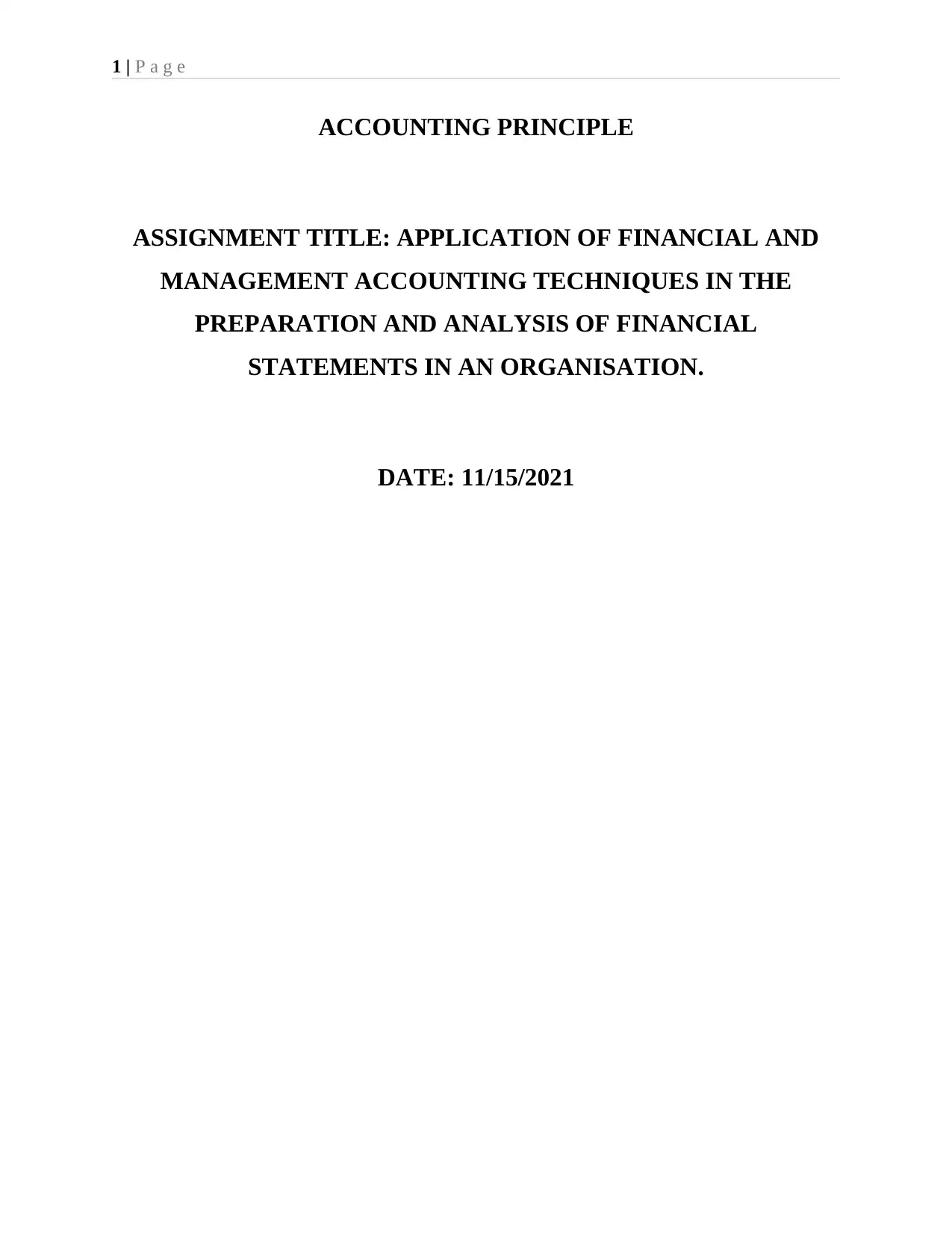
1 | P a g e
ACCOUNTING PRINCIPLE
ASSIGNMENT TITLE: APPLICATION OF FINANCIAL AND
MANAGEMENT ACCOUNTING TECHNIQUES IN THE
PREPARATION AND ANALYSIS OF FINANCIAL
STATEMENTS IN AN ORGANISATION.
DATE: 11/15/2021
ACCOUNTING PRINCIPLE
ASSIGNMENT TITLE: APPLICATION OF FINANCIAL AND
MANAGEMENT ACCOUNTING TECHNIQUES IN THE
PREPARATION AND ANALYSIS OF FINANCIAL
STATEMENTS IN AN ORGANISATION.
DATE: 11/15/2021
Paraphrase This Document
Need a fresh take? Get an instant paraphrase of this document with our AI Paraphraser
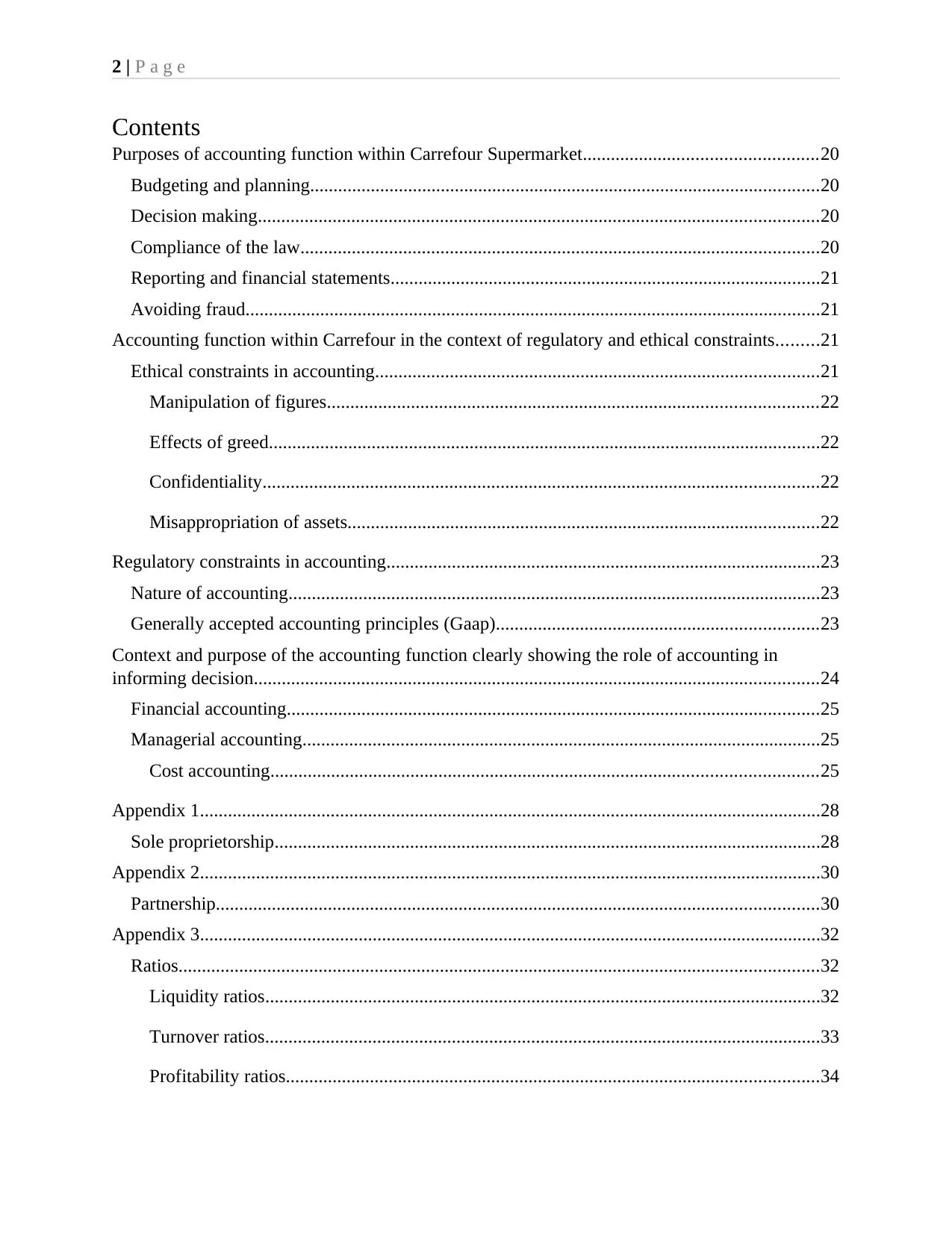
2 | P a g e
Contents
Purposes of accounting function within Carrefour Supermarket..................................................20
Budgeting and planning.............................................................................................................20
Decision making........................................................................................................................20
Compliance of the law...............................................................................................................20
Reporting and financial statements............................................................................................21
Avoiding fraud...........................................................................................................................21
Accounting function within Carrefour in the context of regulatory and ethical constraints.........21
Ethical constraints in accounting...............................................................................................21
Manipulation of figures.........................................................................................................22
Effects of greed......................................................................................................................22
Confidentiality.......................................................................................................................22
Misappropriation of assets.....................................................................................................22
Regulatory constraints in accounting.............................................................................................23
Nature of accounting..................................................................................................................23
Generally accepted accounting principles (Gaap).....................................................................23
Context and purpose of the accounting function clearly showing the role of accounting in
informing decision.........................................................................................................................24
Financial accounting..................................................................................................................25
Managerial accounting...............................................................................................................25
Cost accounting.....................................................................................................................25
Appendix 1.....................................................................................................................................28
Sole proprietorship.....................................................................................................................28
Appendix 2.....................................................................................................................................30
Partnership.................................................................................................................................30
Appendix 3.....................................................................................................................................32
Ratios.........................................................................................................................................32
Liquidity ratios.......................................................................................................................32
Turnover ratios.......................................................................................................................33
Profitability ratios..................................................................................................................34
Contents
Purposes of accounting function within Carrefour Supermarket..................................................20
Budgeting and planning.............................................................................................................20
Decision making........................................................................................................................20
Compliance of the law...............................................................................................................20
Reporting and financial statements............................................................................................21
Avoiding fraud...........................................................................................................................21
Accounting function within Carrefour in the context of regulatory and ethical constraints.........21
Ethical constraints in accounting...............................................................................................21
Manipulation of figures.........................................................................................................22
Effects of greed......................................................................................................................22
Confidentiality.......................................................................................................................22
Misappropriation of assets.....................................................................................................22
Regulatory constraints in accounting.............................................................................................23
Nature of accounting..................................................................................................................23
Generally accepted accounting principles (Gaap).....................................................................23
Context and purpose of the accounting function clearly showing the role of accounting in
informing decision.........................................................................................................................24
Financial accounting..................................................................................................................25
Managerial accounting...............................................................................................................25
Cost accounting.....................................................................................................................25
Appendix 1.....................................................................................................................................28
Sole proprietorship.....................................................................................................................28
Appendix 2.....................................................................................................................................30
Partnership.................................................................................................................................30
Appendix 3.....................................................................................................................................32
Ratios.........................................................................................................................................32
Liquidity ratios.......................................................................................................................32
Turnover ratios.......................................................................................................................33
Profitability ratios..................................................................................................................34
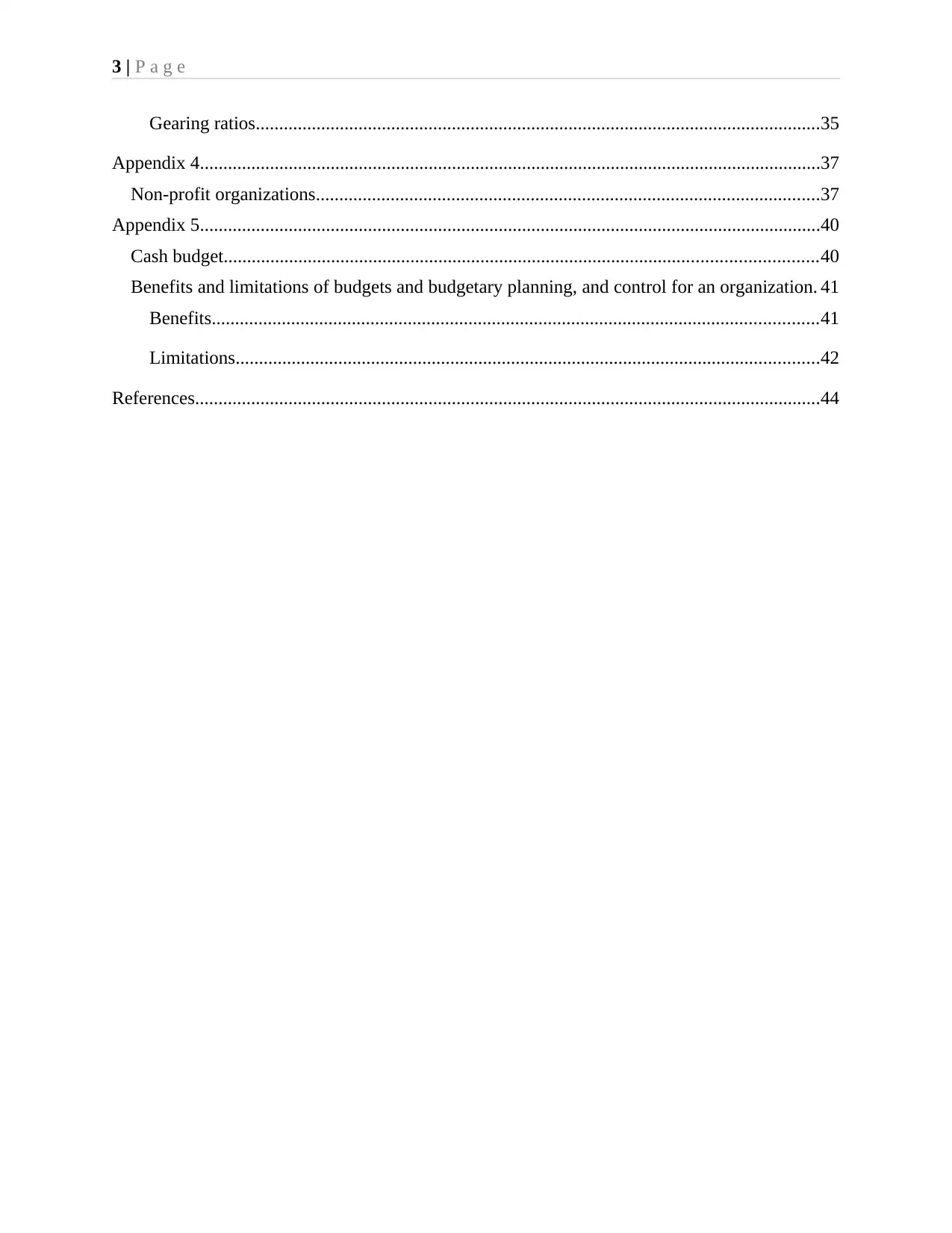
3 | P a g e
Gearing ratios.........................................................................................................................35
Appendix 4.....................................................................................................................................37
Non-profit organizations............................................................................................................37
Appendix 5.....................................................................................................................................40
Cash budget...............................................................................................................................40
Benefits and limitations of budgets and budgetary planning, and control for an organization. 41
Benefits..................................................................................................................................41
Limitations.............................................................................................................................42
References......................................................................................................................................44
Gearing ratios.........................................................................................................................35
Appendix 4.....................................................................................................................................37
Non-profit organizations............................................................................................................37
Appendix 5.....................................................................................................................................40
Cash budget...............................................................................................................................40
Benefits and limitations of budgets and budgetary planning, and control for an organization. 41
Benefits..................................................................................................................................41
Limitations.............................................................................................................................42
References......................................................................................................................................44
⊘ This is a preview!⊘
Do you want full access?
Subscribe today to unlock all pages.

Trusted by 1+ million students worldwide
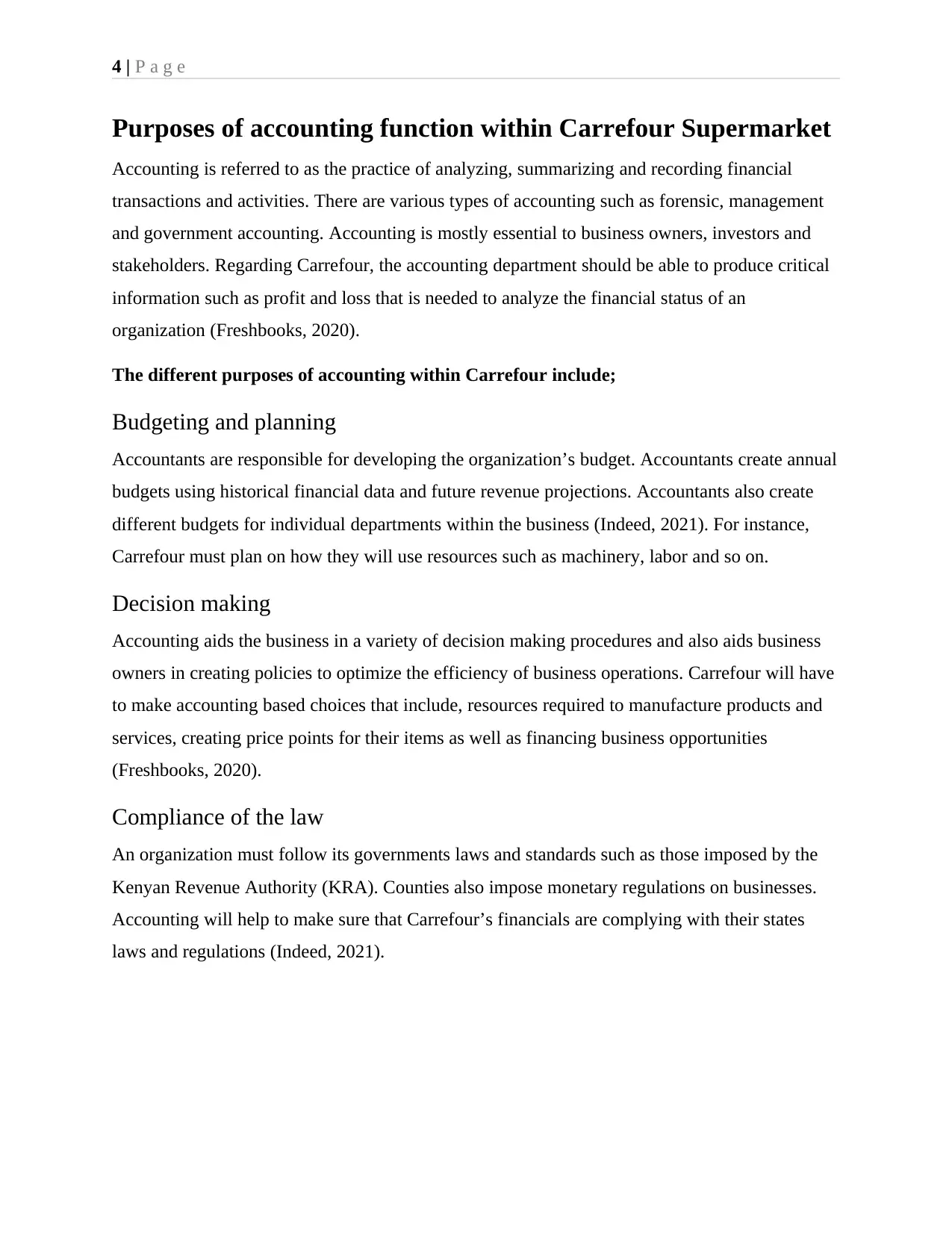
4 | P a g e
Purposes of accounting function within Carrefour Supermarket
Accounting is referred to as the practice of analyzing, summarizing and recording financial
transactions and activities. There are various types of accounting such as forensic, management
and government accounting. Accounting is mostly essential to business owners, investors and
stakeholders. Regarding Carrefour, the accounting department should be able to produce critical
information such as profit and loss that is needed to analyze the financial status of an
organization (Freshbooks, 2020).
The different purposes of accounting within Carrefour include;
Budgeting and planning
Accountants are responsible for developing the organization’s budget. Accountants create annual
budgets using historical financial data and future revenue projections. Accountants also create
different budgets for individual departments within the business (Indeed, 2021). For instance,
Carrefour must plan on how they will use resources such as machinery, labor and so on.
Decision making
Accounting aids the business in a variety of decision making procedures and also aids business
owners in creating policies to optimize the efficiency of business operations. Carrefour will have
to make accounting based choices that include, resources required to manufacture products and
services, creating price points for their items as well as financing business opportunities
(Freshbooks, 2020).
Compliance of the law
An organization must follow its governments laws and standards such as those imposed by the
Kenyan Revenue Authority (KRA). Counties also impose monetary regulations on businesses.
Accounting will help to make sure that Carrefour’s financials are complying with their states
laws and regulations (Indeed, 2021).
Purposes of accounting function within Carrefour Supermarket
Accounting is referred to as the practice of analyzing, summarizing and recording financial
transactions and activities. There are various types of accounting such as forensic, management
and government accounting. Accounting is mostly essential to business owners, investors and
stakeholders. Regarding Carrefour, the accounting department should be able to produce critical
information such as profit and loss that is needed to analyze the financial status of an
organization (Freshbooks, 2020).
The different purposes of accounting within Carrefour include;
Budgeting and planning
Accountants are responsible for developing the organization’s budget. Accountants create annual
budgets using historical financial data and future revenue projections. Accountants also create
different budgets for individual departments within the business (Indeed, 2021). For instance,
Carrefour must plan on how they will use resources such as machinery, labor and so on.
Decision making
Accounting aids the business in a variety of decision making procedures and also aids business
owners in creating policies to optimize the efficiency of business operations. Carrefour will have
to make accounting based choices that include, resources required to manufacture products and
services, creating price points for their items as well as financing business opportunities
(Freshbooks, 2020).
Compliance of the law
An organization must follow its governments laws and standards such as those imposed by the
Kenyan Revenue Authority (KRA). Counties also impose monetary regulations on businesses.
Accounting will help to make sure that Carrefour’s financials are complying with their states
laws and regulations (Indeed, 2021).
Paraphrase This Document
Need a fresh take? Get an instant paraphrase of this document with our AI Paraphraser
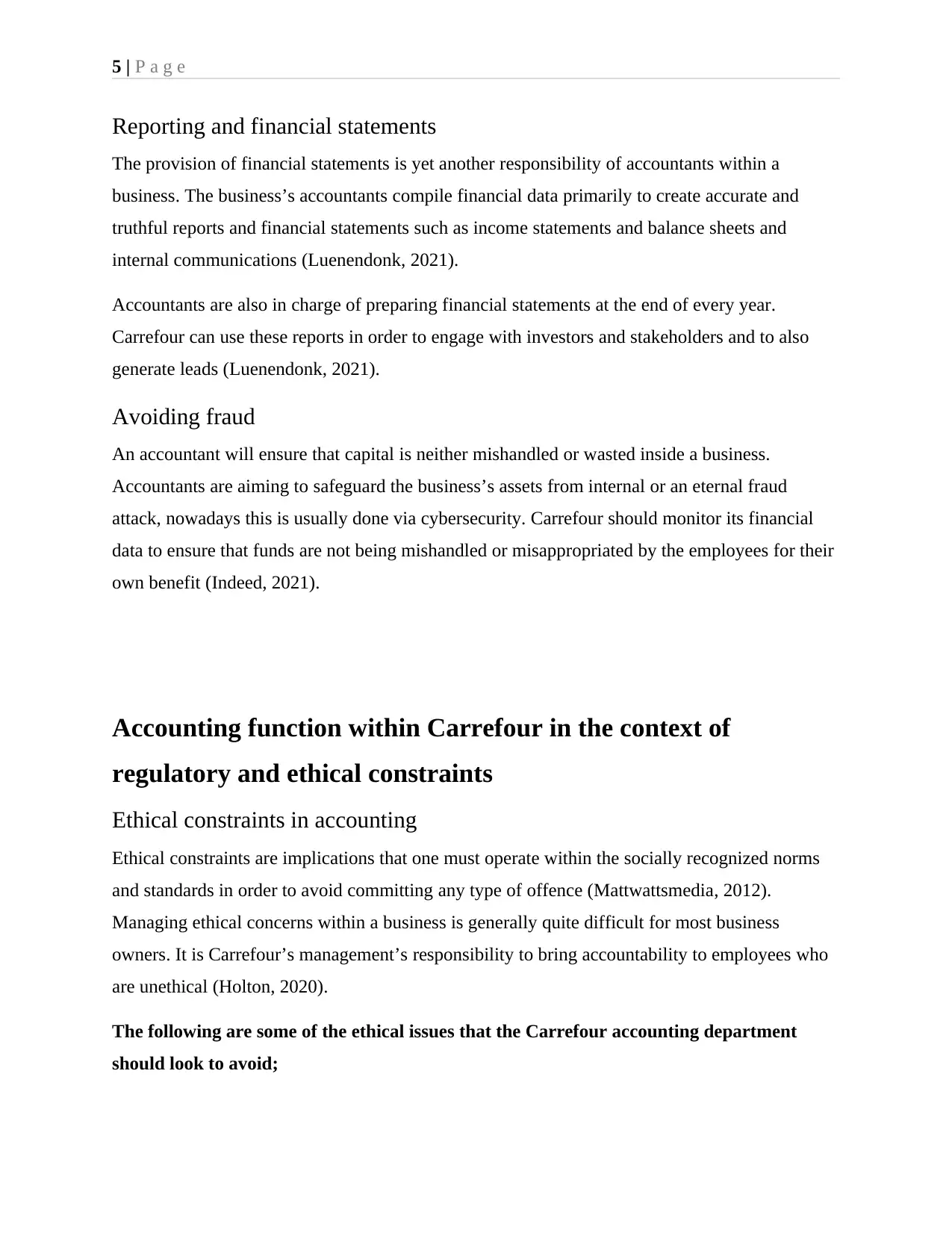
5 | P a g e
Reporting and financial statements
The provision of financial statements is yet another responsibility of accountants within a
business. The business’s accountants compile financial data primarily to create accurate and
truthful reports and financial statements such as income statements and balance sheets and
internal communications (Luenendonk, 2021).
Accountants are also in charge of preparing financial statements at the end of every year.
Carrefour can use these reports in order to engage with investors and stakeholders and to also
generate leads (Luenendonk, 2021).
Avoiding fraud
An accountant will ensure that capital is neither mishandled or wasted inside a business.
Accountants are aiming to safeguard the business’s assets from internal or an eternal fraud
attack, nowadays this is usually done via cybersecurity. Carrefour should monitor its financial
data to ensure that funds are not being mishandled or misappropriated by the employees for their
own benefit (Indeed, 2021).
Accounting function within Carrefour in the context of
regulatory and ethical constraints
Ethical constraints in accounting
Ethical constraints are implications that one must operate within the socially recognized norms
and standards in order to avoid committing any type of offence (Mattwattsmedia, 2012).
Managing ethical concerns within a business is generally quite difficult for most business
owners. It is Carrefour’s management’s responsibility to bring accountability to employees who
are unethical (Holton, 2020).
The following are some of the ethical issues that the Carrefour accounting department
should look to avoid;
Reporting and financial statements
The provision of financial statements is yet another responsibility of accountants within a
business. The business’s accountants compile financial data primarily to create accurate and
truthful reports and financial statements such as income statements and balance sheets and
internal communications (Luenendonk, 2021).
Accountants are also in charge of preparing financial statements at the end of every year.
Carrefour can use these reports in order to engage with investors and stakeholders and to also
generate leads (Luenendonk, 2021).
Avoiding fraud
An accountant will ensure that capital is neither mishandled or wasted inside a business.
Accountants are aiming to safeguard the business’s assets from internal or an eternal fraud
attack, nowadays this is usually done via cybersecurity. Carrefour should monitor its financial
data to ensure that funds are not being mishandled or misappropriated by the employees for their
own benefit (Indeed, 2021).
Accounting function within Carrefour in the context of
regulatory and ethical constraints
Ethical constraints in accounting
Ethical constraints are implications that one must operate within the socially recognized norms
and standards in order to avoid committing any type of offence (Mattwattsmedia, 2012).
Managing ethical concerns within a business is generally quite difficult for most business
owners. It is Carrefour’s management’s responsibility to bring accountability to employees who
are unethical (Holton, 2020).
The following are some of the ethical issues that the Carrefour accounting department
should look to avoid;
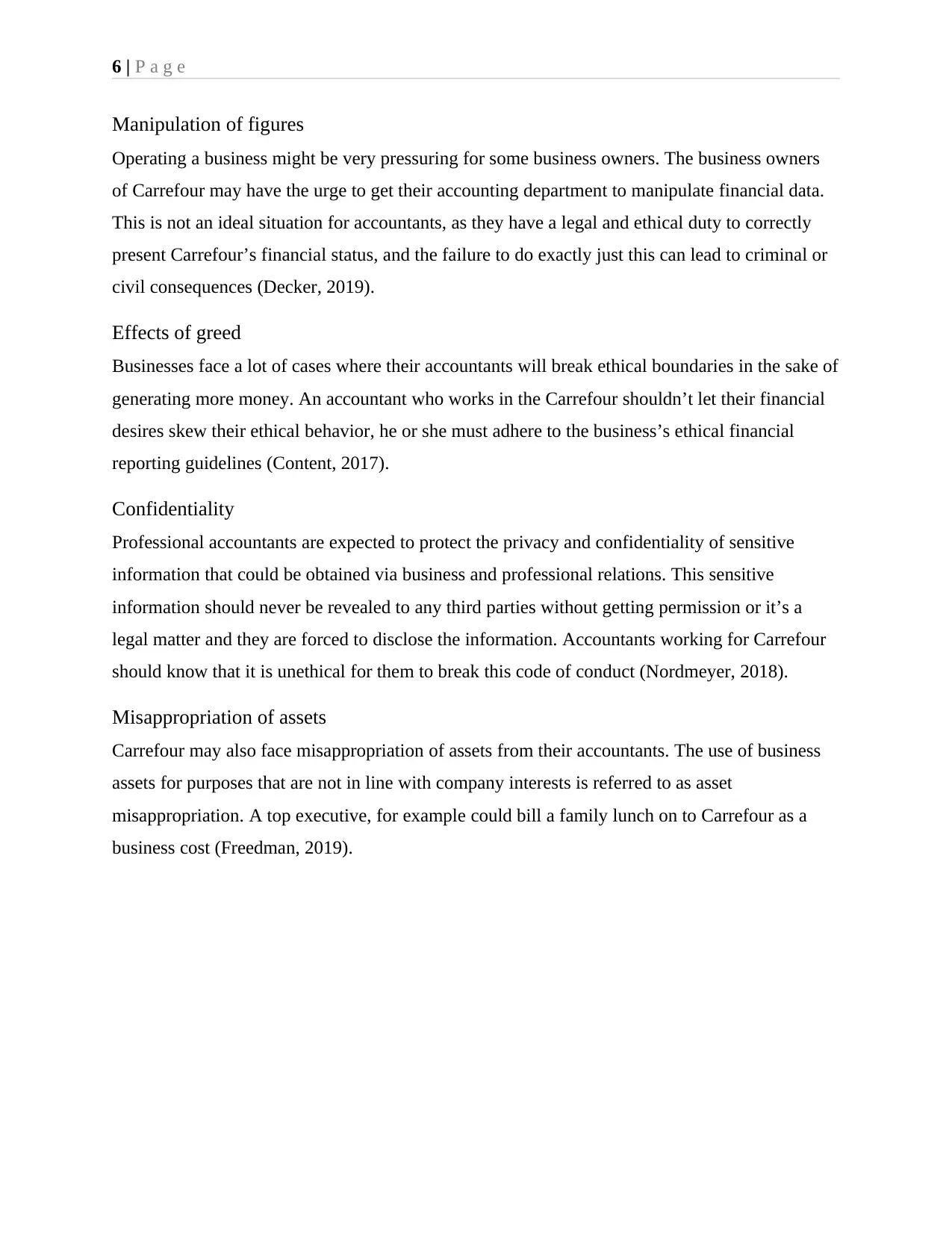
6 | P a g e
Manipulation of figures
Operating a business might be very pressuring for some business owners. The business owners
of Carrefour may have the urge to get their accounting department to manipulate financial data.
This is not an ideal situation for accountants, as they have a legal and ethical duty to correctly
present Carrefour’s financial status, and the failure to do exactly just this can lead to criminal or
civil consequences (Decker, 2019).
Effects of greed
Businesses face a lot of cases where their accountants will break ethical boundaries in the sake of
generating more money. An accountant who works in the Carrefour shouldn’t let their financial
desires skew their ethical behavior, he or she must adhere to the business’s ethical financial
reporting guidelines (Content, 2017).
Confidentiality
Professional accountants are expected to protect the privacy and confidentiality of sensitive
information that could be obtained via business and professional relations. This sensitive
information should never be revealed to any third parties without getting permission or it’s a
legal matter and they are forced to disclose the information. Accountants working for Carrefour
should know that it is unethical for them to break this code of conduct (Nordmeyer, 2018).
Misappropriation of assets
Carrefour may also face misappropriation of assets from their accountants. The use of business
assets for purposes that are not in line with company interests is referred to as asset
misappropriation. A top executive, for example could bill a family lunch on to Carrefour as a
business cost (Freedman, 2019).
Manipulation of figures
Operating a business might be very pressuring for some business owners. The business owners
of Carrefour may have the urge to get their accounting department to manipulate financial data.
This is not an ideal situation for accountants, as they have a legal and ethical duty to correctly
present Carrefour’s financial status, and the failure to do exactly just this can lead to criminal or
civil consequences (Decker, 2019).
Effects of greed
Businesses face a lot of cases where their accountants will break ethical boundaries in the sake of
generating more money. An accountant who works in the Carrefour shouldn’t let their financial
desires skew their ethical behavior, he or she must adhere to the business’s ethical financial
reporting guidelines (Content, 2017).
Confidentiality
Professional accountants are expected to protect the privacy and confidentiality of sensitive
information that could be obtained via business and professional relations. This sensitive
information should never be revealed to any third parties without getting permission or it’s a
legal matter and they are forced to disclose the information. Accountants working for Carrefour
should know that it is unethical for them to break this code of conduct (Nordmeyer, 2018).
Misappropriation of assets
Carrefour may also face misappropriation of assets from their accountants. The use of business
assets for purposes that are not in line with company interests is referred to as asset
misappropriation. A top executive, for example could bill a family lunch on to Carrefour as a
business cost (Freedman, 2019).
⊘ This is a preview!⊘
Do you want full access?
Subscribe today to unlock all pages.

Trusted by 1+ million students worldwide
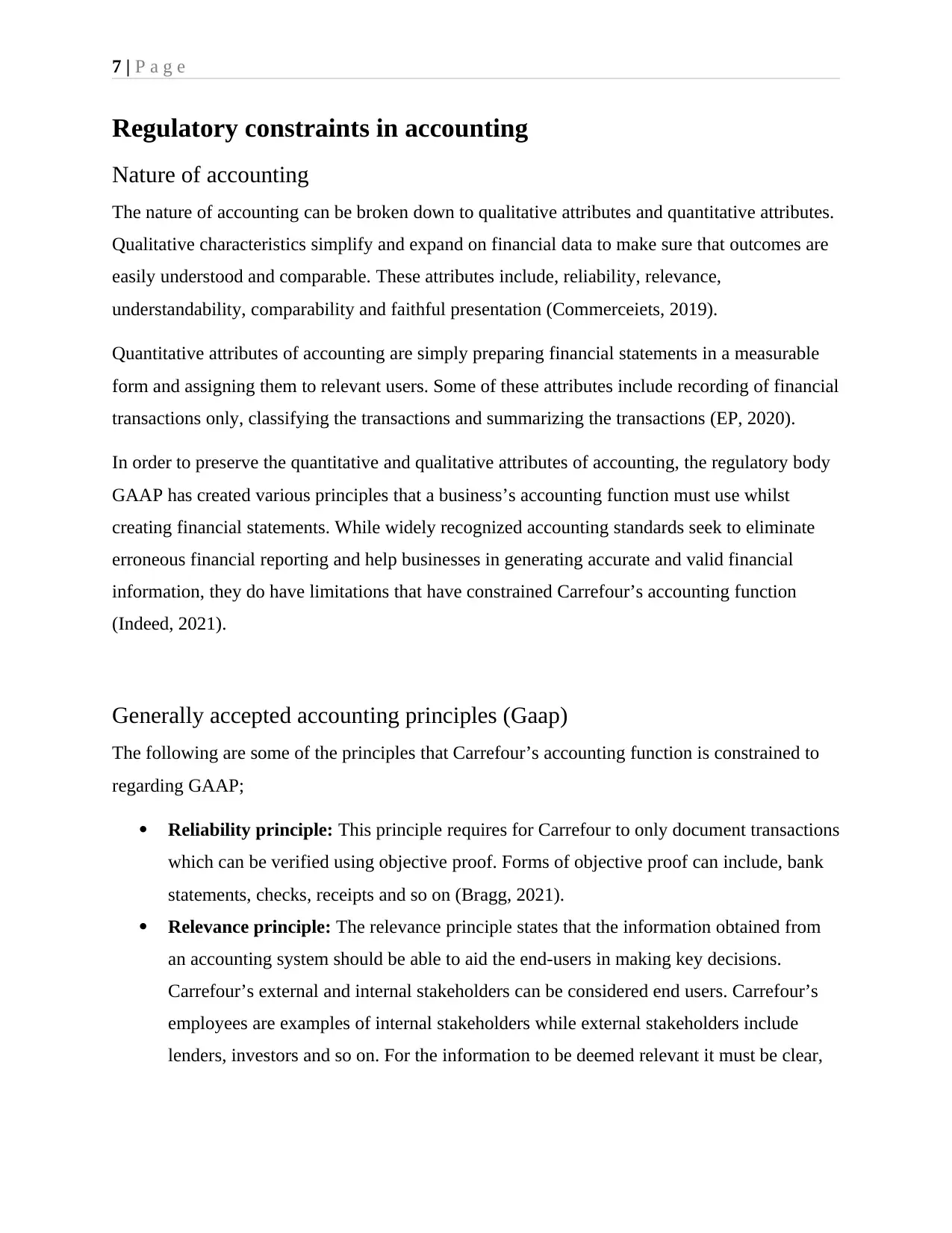
7 | P a g e
Regulatory constraints in accounting
Nature of accounting
The nature of accounting can be broken down to qualitative attributes and quantitative attributes.
Qualitative characteristics simplify and expand on financial data to make sure that outcomes are
easily understood and comparable. These attributes include, reliability, relevance,
understandability, comparability and faithful presentation (Commerceiets, 2019).
Quantitative attributes of accounting are simply preparing financial statements in a measurable
form and assigning them to relevant users. Some of these attributes include recording of financial
transactions only, classifying the transactions and summarizing the transactions (EP, 2020).
In order to preserve the quantitative and qualitative attributes of accounting, the regulatory body
GAAP has created various principles that a business’s accounting function must use whilst
creating financial statements. While widely recognized accounting standards seek to eliminate
erroneous financial reporting and help businesses in generating accurate and valid financial
information, they do have limitations that have constrained Carrefour’s accounting function
(Indeed, 2021).
Generally accepted accounting principles (Gaap)
The following are some of the principles that Carrefour’s accounting function is constrained to
regarding GAAP;
Reliability principle: This principle requires for Carrefour to only document transactions
which can be verified using objective proof. Forms of objective proof can include, bank
statements, checks, receipts and so on (Bragg, 2021).
Relevance principle: The relevance principle states that the information obtained from
an accounting system should be able to aid the end-users in making key decisions.
Carrefour’s external and internal stakeholders can be considered end users. Carrefour’s
employees are examples of internal stakeholders while external stakeholders include
lenders, investors and so on. For the information to be deemed relevant it must be clear,
Regulatory constraints in accounting
Nature of accounting
The nature of accounting can be broken down to qualitative attributes and quantitative attributes.
Qualitative characteristics simplify and expand on financial data to make sure that outcomes are
easily understood and comparable. These attributes include, reliability, relevance,
understandability, comparability and faithful presentation (Commerceiets, 2019).
Quantitative attributes of accounting are simply preparing financial statements in a measurable
form and assigning them to relevant users. Some of these attributes include recording of financial
transactions only, classifying the transactions and summarizing the transactions (EP, 2020).
In order to preserve the quantitative and qualitative attributes of accounting, the regulatory body
GAAP has created various principles that a business’s accounting function must use whilst
creating financial statements. While widely recognized accounting standards seek to eliminate
erroneous financial reporting and help businesses in generating accurate and valid financial
information, they do have limitations that have constrained Carrefour’s accounting function
(Indeed, 2021).
Generally accepted accounting principles (Gaap)
The following are some of the principles that Carrefour’s accounting function is constrained to
regarding GAAP;
Reliability principle: This principle requires for Carrefour to only document transactions
which can be verified using objective proof. Forms of objective proof can include, bank
statements, checks, receipts and so on (Bragg, 2021).
Relevance principle: The relevance principle states that the information obtained from
an accounting system should be able to aid the end-users in making key decisions.
Carrefour’s external and internal stakeholders can be considered end users. Carrefour’s
employees are examples of internal stakeholders while external stakeholders include
lenders, investors and so on. For the information to be deemed relevant it must be clear,
Paraphrase This Document
Need a fresh take? Get an instant paraphrase of this document with our AI Paraphraser
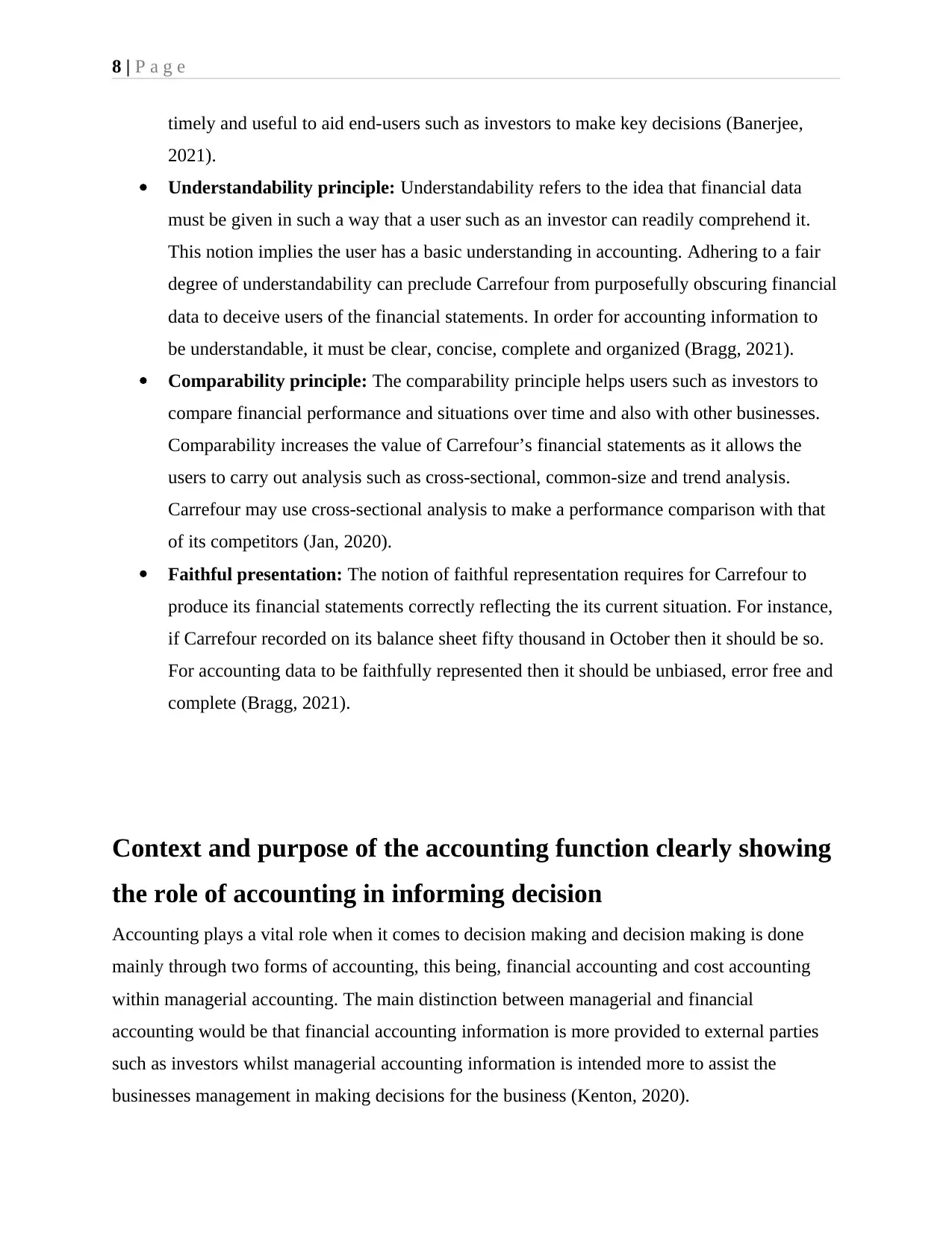
8 | P a g e
timely and useful to aid end-users such as investors to make key decisions (Banerjee,
2021).
Understandability principle: Understandability refers to the idea that financial data
must be given in such a way that a user such as an investor can readily comprehend it.
This notion implies the user has a basic understanding in accounting. Adhering to a fair
degree of understandability can preclude Carrefour from purposefully obscuring financial
data to deceive users of the financial statements. In order for accounting information to
be understandable, it must be clear, concise, complete and organized (Bragg, 2021).
Comparability principle: The comparability principle helps users such as investors to
compare financial performance and situations over time and also with other businesses.
Comparability increases the value of Carrefour’s financial statements as it allows the
users to carry out analysis such as cross-sectional, common-size and trend analysis.
Carrefour may use cross-sectional analysis to make a performance comparison with that
of its competitors (Jan, 2020).
Faithful presentation: The notion of faithful representation requires for Carrefour to
produce its financial statements correctly reflecting the its current situation. For instance,
if Carrefour recorded on its balance sheet fifty thousand in October then it should be so.
For accounting data to be faithfully represented then it should be unbiased, error free and
complete (Bragg, 2021).
Context and purpose of the accounting function clearly showing
the role of accounting in informing decision
Accounting plays a vital role when it comes to decision making and decision making is done
mainly through two forms of accounting, this being, financial accounting and cost accounting
within managerial accounting. The main distinction between managerial and financial
accounting would be that financial accounting information is more provided to external parties
such as investors whilst managerial accounting information is intended more to assist the
businesses management in making decisions for the business (Kenton, 2020).
timely and useful to aid end-users such as investors to make key decisions (Banerjee,
2021).
Understandability principle: Understandability refers to the idea that financial data
must be given in such a way that a user such as an investor can readily comprehend it.
This notion implies the user has a basic understanding in accounting. Adhering to a fair
degree of understandability can preclude Carrefour from purposefully obscuring financial
data to deceive users of the financial statements. In order for accounting information to
be understandable, it must be clear, concise, complete and organized (Bragg, 2021).
Comparability principle: The comparability principle helps users such as investors to
compare financial performance and situations over time and also with other businesses.
Comparability increases the value of Carrefour’s financial statements as it allows the
users to carry out analysis such as cross-sectional, common-size and trend analysis.
Carrefour may use cross-sectional analysis to make a performance comparison with that
of its competitors (Jan, 2020).
Faithful presentation: The notion of faithful representation requires for Carrefour to
produce its financial statements correctly reflecting the its current situation. For instance,
if Carrefour recorded on its balance sheet fifty thousand in October then it should be so.
For accounting data to be faithfully represented then it should be unbiased, error free and
complete (Bragg, 2021).
Context and purpose of the accounting function clearly showing
the role of accounting in informing decision
Accounting plays a vital role when it comes to decision making and decision making is done
mainly through two forms of accounting, this being, financial accounting and cost accounting
within managerial accounting. The main distinction between managerial and financial
accounting would be that financial accounting information is more provided to external parties
such as investors whilst managerial accounting information is intended more to assist the
businesses management in making decisions for the business (Kenton, 2020).
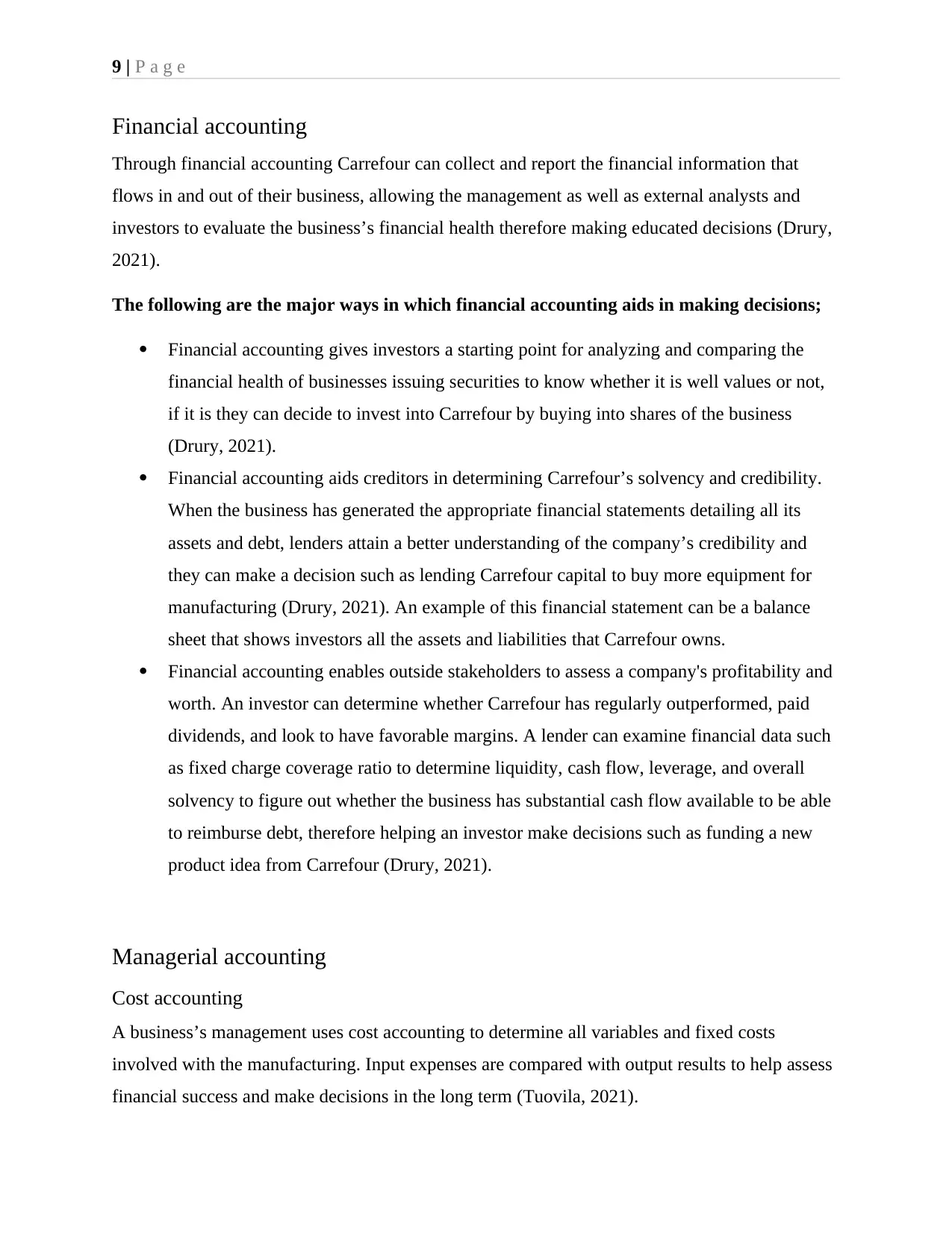
9 | P a g e
Financial accounting
Through financial accounting Carrefour can collect and report the financial information that
flows in and out of their business, allowing the management as well as external analysts and
investors to evaluate the business’s financial health therefore making educated decisions (Drury,
2021).
The following are the major ways in which financial accounting aids in making decisions;
Financial accounting gives investors a starting point for analyzing and comparing the
financial health of businesses issuing securities to know whether it is well values or not,
if it is they can decide to invest into Carrefour by buying into shares of the business
(Drury, 2021).
Financial accounting aids creditors in determining Carrefour’s solvency and credibility.
When the business has generated the appropriate financial statements detailing all its
assets and debt, lenders attain a better understanding of the company’s credibility and
they can make a decision such as lending Carrefour capital to buy more equipment for
manufacturing (Drury, 2021). An example of this financial statement can be a balance
sheet that shows investors all the assets and liabilities that Carrefour owns.
Financial accounting enables outside stakeholders to assess a company's profitability and
worth. An investor can determine whether Carrefour has regularly outperformed, paid
dividends, and look to have favorable margins. A lender can examine financial data such
as fixed charge coverage ratio to determine liquidity, cash flow, leverage, and overall
solvency to figure out whether the business has substantial cash flow available to be able
to reimburse debt, therefore helping an investor make decisions such as funding a new
product idea from Carrefour (Drury, 2021).
Managerial accounting
Cost accounting
A business’s management uses cost accounting to determine all variables and fixed costs
involved with the manufacturing. Input expenses are compared with output results to help assess
financial success and make decisions in the long term (Tuovila, 2021).
Financial accounting
Through financial accounting Carrefour can collect and report the financial information that
flows in and out of their business, allowing the management as well as external analysts and
investors to evaluate the business’s financial health therefore making educated decisions (Drury,
2021).
The following are the major ways in which financial accounting aids in making decisions;
Financial accounting gives investors a starting point for analyzing and comparing the
financial health of businesses issuing securities to know whether it is well values or not,
if it is they can decide to invest into Carrefour by buying into shares of the business
(Drury, 2021).
Financial accounting aids creditors in determining Carrefour’s solvency and credibility.
When the business has generated the appropriate financial statements detailing all its
assets and debt, lenders attain a better understanding of the company’s credibility and
they can make a decision such as lending Carrefour capital to buy more equipment for
manufacturing (Drury, 2021). An example of this financial statement can be a balance
sheet that shows investors all the assets and liabilities that Carrefour owns.
Financial accounting enables outside stakeholders to assess a company's profitability and
worth. An investor can determine whether Carrefour has regularly outperformed, paid
dividends, and look to have favorable margins. A lender can examine financial data such
as fixed charge coverage ratio to determine liquidity, cash flow, leverage, and overall
solvency to figure out whether the business has substantial cash flow available to be able
to reimburse debt, therefore helping an investor make decisions such as funding a new
product idea from Carrefour (Drury, 2021).
Managerial accounting
Cost accounting
A business’s management uses cost accounting to determine all variables and fixed costs
involved with the manufacturing. Input expenses are compared with output results to help assess
financial success and make decisions in the long term (Tuovila, 2021).
⊘ This is a preview!⊘
Do you want full access?
Subscribe today to unlock all pages.

Trusted by 1+ million students worldwide
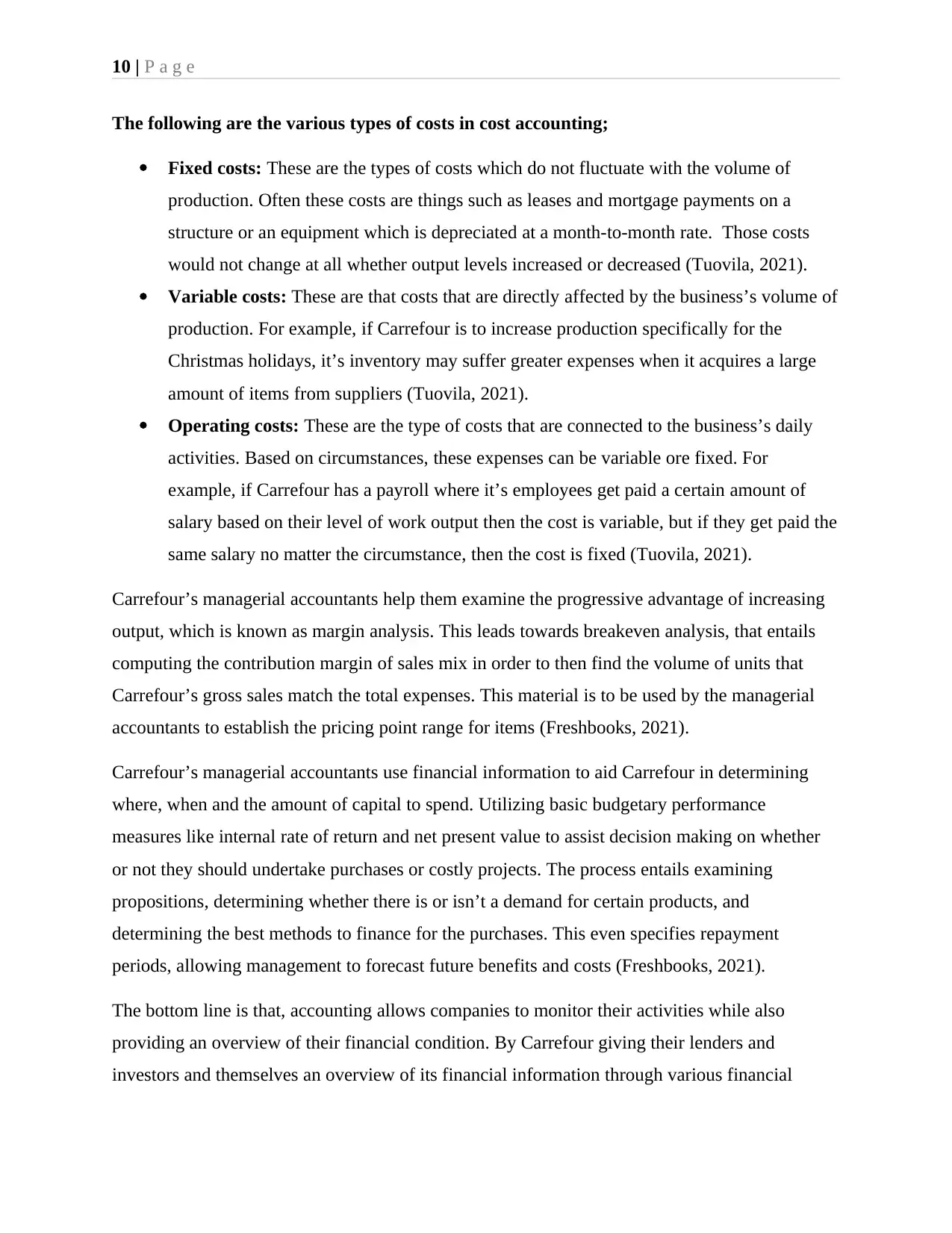
10 | P a g e
The following are the various types of costs in cost accounting;
Fixed costs: These are the types of costs which do not fluctuate with the volume of
production. Often these costs are things such as leases and mortgage payments on a
structure or an equipment which is depreciated at a month-to-month rate. Those costs
would not change at all whether output levels increased or decreased (Tuovila, 2021).
Variable costs: These are that costs that are directly affected by the business’s volume of
production. For example, if Carrefour is to increase production specifically for the
Christmas holidays, it’s inventory may suffer greater expenses when it acquires a large
amount of items from suppliers (Tuovila, 2021).
Operating costs: These are the type of costs that are connected to the business’s daily
activities. Based on circumstances, these expenses can be variable ore fixed. For
example, if Carrefour has a payroll where it’s employees get paid a certain amount of
salary based on their level of work output then the cost is variable, but if they get paid the
same salary no matter the circumstance, then the cost is fixed (Tuovila, 2021).
Carrefour’s managerial accountants help them examine the progressive advantage of increasing
output, which is known as margin analysis. This leads towards breakeven analysis, that entails
computing the contribution margin of sales mix in order to then find the volume of units that
Carrefour’s gross sales match the total expenses. This material is to be used by the managerial
accountants to establish the pricing point range for items (Freshbooks, 2021).
Carrefour’s managerial accountants use financial information to aid Carrefour in determining
where, when and the amount of capital to spend. Utilizing basic budgetary performance
measures like internal rate of return and net present value to assist decision making on whether
or not they should undertake purchases or costly projects. The process entails examining
propositions, determining whether there is or isn’t a demand for certain products, and
determining the best methods to finance for the purchases. This even specifies repayment
periods, allowing management to forecast future benefits and costs (Freshbooks, 2021).
The bottom line is that, accounting allows companies to monitor their activities while also
providing an overview of their financial condition. By Carrefour giving their lenders and
investors and themselves an overview of its financial information through various financial
The following are the various types of costs in cost accounting;
Fixed costs: These are the types of costs which do not fluctuate with the volume of
production. Often these costs are things such as leases and mortgage payments on a
structure or an equipment which is depreciated at a month-to-month rate. Those costs
would not change at all whether output levels increased or decreased (Tuovila, 2021).
Variable costs: These are that costs that are directly affected by the business’s volume of
production. For example, if Carrefour is to increase production specifically for the
Christmas holidays, it’s inventory may suffer greater expenses when it acquires a large
amount of items from suppliers (Tuovila, 2021).
Operating costs: These are the type of costs that are connected to the business’s daily
activities. Based on circumstances, these expenses can be variable ore fixed. For
example, if Carrefour has a payroll where it’s employees get paid a certain amount of
salary based on their level of work output then the cost is variable, but if they get paid the
same salary no matter the circumstance, then the cost is fixed (Tuovila, 2021).
Carrefour’s managerial accountants help them examine the progressive advantage of increasing
output, which is known as margin analysis. This leads towards breakeven analysis, that entails
computing the contribution margin of sales mix in order to then find the volume of units that
Carrefour’s gross sales match the total expenses. This material is to be used by the managerial
accountants to establish the pricing point range for items (Freshbooks, 2021).
Carrefour’s managerial accountants use financial information to aid Carrefour in determining
where, when and the amount of capital to spend. Utilizing basic budgetary performance
measures like internal rate of return and net present value to assist decision making on whether
or not they should undertake purchases or costly projects. The process entails examining
propositions, determining whether there is or isn’t a demand for certain products, and
determining the best methods to finance for the purchases. This even specifies repayment
periods, allowing management to forecast future benefits and costs (Freshbooks, 2021).
The bottom line is that, accounting allows companies to monitor their activities while also
providing an overview of their financial condition. By Carrefour giving their lenders and
investors and themselves an overview of its financial information through various financial
Paraphrase This Document
Need a fresh take? Get an instant paraphrase of this document with our AI Paraphraser
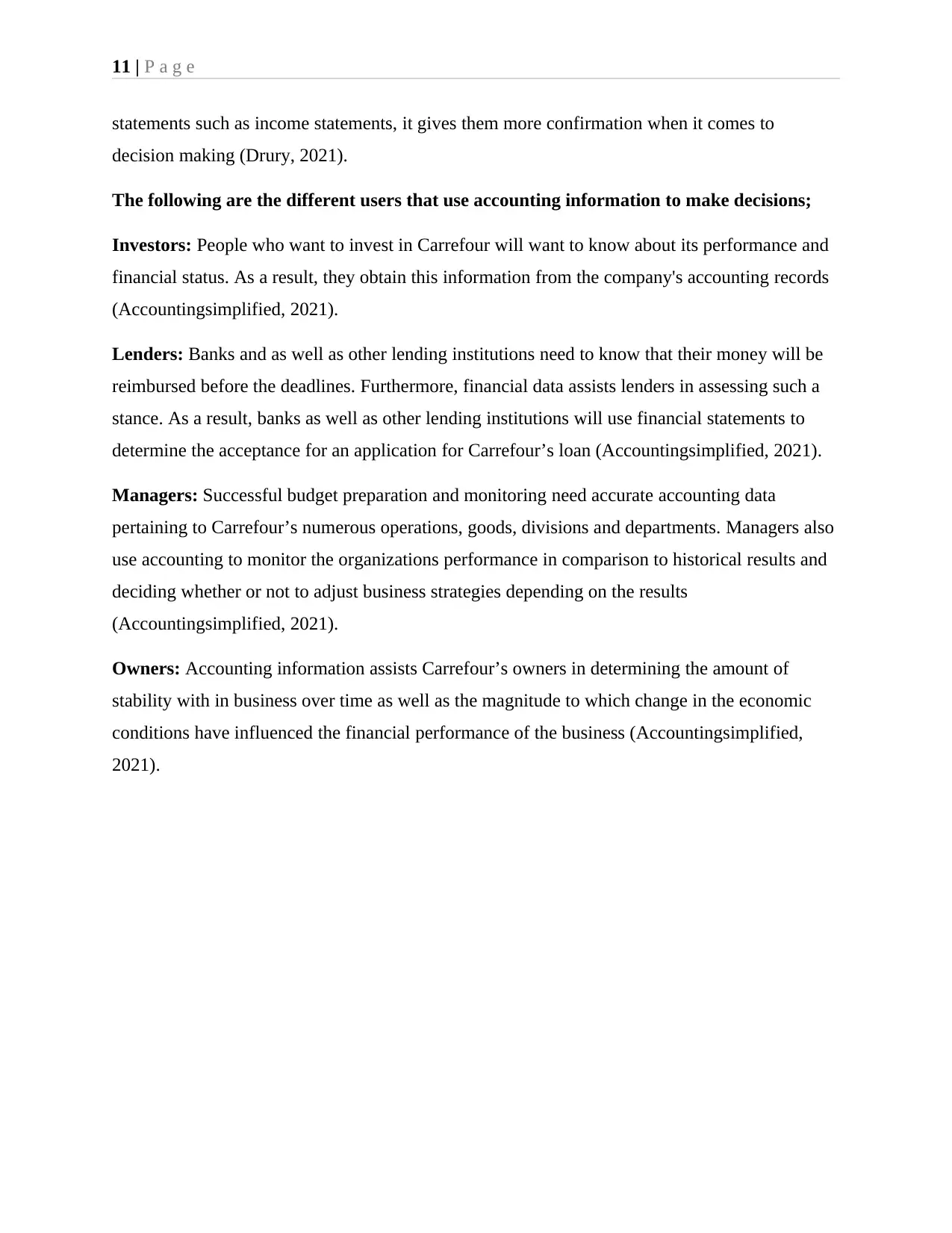
11 | P a g e
statements such as income statements, it gives them more confirmation when it comes to
decision making (Drury, 2021).
The following are the different users that use accounting information to make decisions;
Investors: People who want to invest in Carrefour will want to know about its performance and
financial status. As a result, they obtain this information from the company's accounting records
(Accountingsimplified, 2021).
Lenders: Banks and as well as other lending institutions need to know that their money will be
reimbursed before the deadlines. Furthermore, financial data assists lenders in assessing such a
stance. As a result, banks as well as other lending institutions will use financial statements to
determine the acceptance for an application for Carrefour’s loan (Accountingsimplified, 2021).
Managers: Successful budget preparation and monitoring need accurate accounting data
pertaining to Carrefour’s numerous operations, goods, divisions and departments. Managers also
use accounting to monitor the organizations performance in comparison to historical results and
deciding whether or not to adjust business strategies depending on the results
(Accountingsimplified, 2021).
Owners: Accounting information assists Carrefour’s owners in determining the amount of
stability with in business over time as well as the magnitude to which change in the economic
conditions have influenced the financial performance of the business (Accountingsimplified,
2021).
statements such as income statements, it gives them more confirmation when it comes to
decision making (Drury, 2021).
The following are the different users that use accounting information to make decisions;
Investors: People who want to invest in Carrefour will want to know about its performance and
financial status. As a result, they obtain this information from the company's accounting records
(Accountingsimplified, 2021).
Lenders: Banks and as well as other lending institutions need to know that their money will be
reimbursed before the deadlines. Furthermore, financial data assists lenders in assessing such a
stance. As a result, banks as well as other lending institutions will use financial statements to
determine the acceptance for an application for Carrefour’s loan (Accountingsimplified, 2021).
Managers: Successful budget preparation and monitoring need accurate accounting data
pertaining to Carrefour’s numerous operations, goods, divisions and departments. Managers also
use accounting to monitor the organizations performance in comparison to historical results and
deciding whether or not to adjust business strategies depending on the results
(Accountingsimplified, 2021).
Owners: Accounting information assists Carrefour’s owners in determining the amount of
stability with in business over time as well as the magnitude to which change in the economic
conditions have influenced the financial performance of the business (Accountingsimplified,
2021).
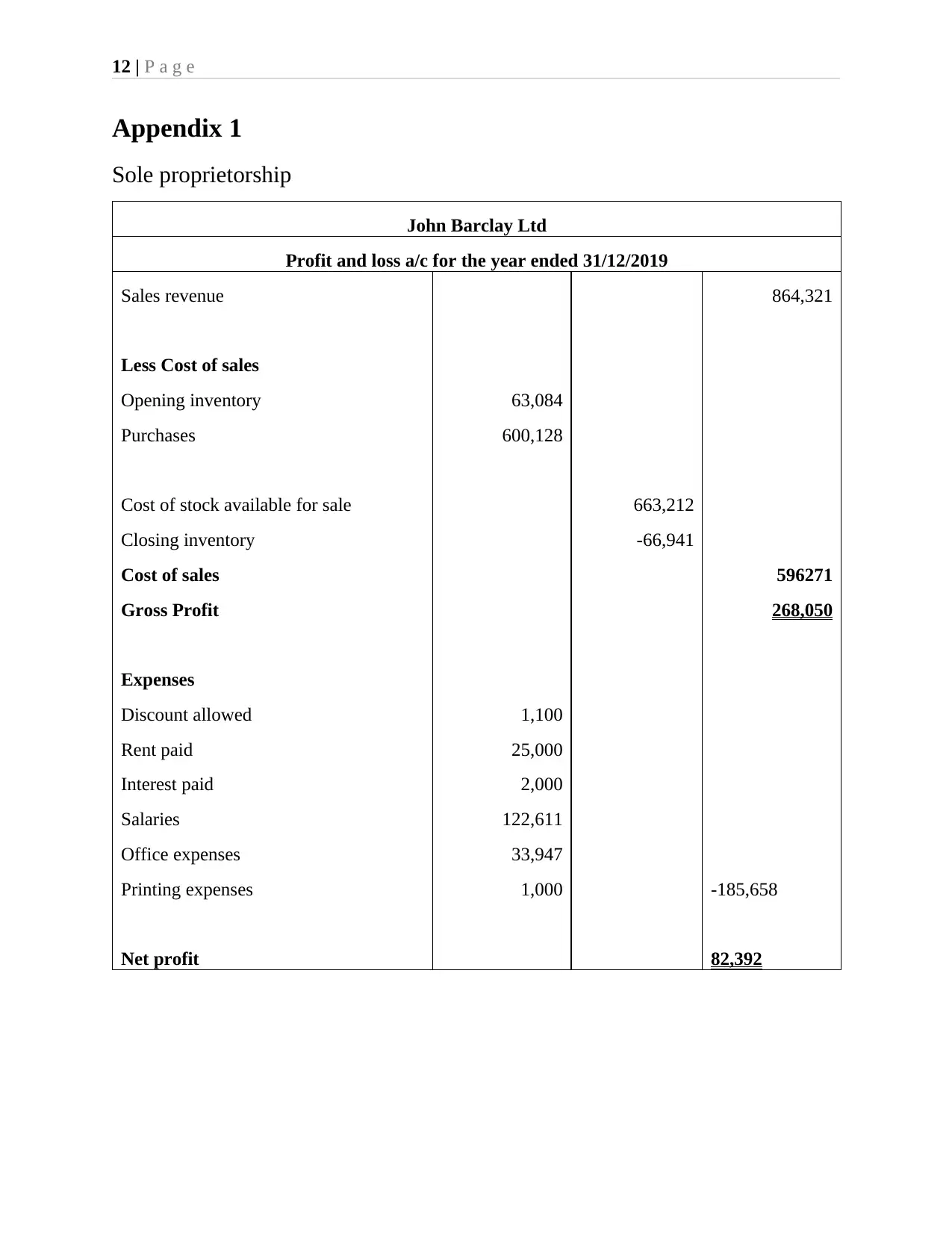
12 | P a g e
Appendix 1
Sole proprietorship
John Barclay Ltd
Profit and loss a/c for the year ended 31/12/2019
Sales revenue 864,321
Less Cost of sales
Opening inventory 63,084
Purchases 600,128
Cost of stock available for sale 663,212
Closing inventory -66,941
Cost of sales 596271
Gross Profit 268,050
Expenses
Discount allowed 1,100
Rent paid 25,000
Interest paid 2,000
Salaries 122,611
Office expenses 33,947
Printing expenses 1,000 -185,658
Net profit 82,392
Appendix 1
Sole proprietorship
John Barclay Ltd
Profit and loss a/c for the year ended 31/12/2019
Sales revenue 864,321
Less Cost of sales
Opening inventory 63,084
Purchases 600,128
Cost of stock available for sale 663,212
Closing inventory -66,941
Cost of sales 596271
Gross Profit 268,050
Expenses
Discount allowed 1,100
Rent paid 25,000
Interest paid 2,000
Salaries 122,611
Office expenses 33,947
Printing expenses 1,000 -185,658
Net profit 82,392
⊘ This is a preview!⊘
Do you want full access?
Subscribe today to unlock all pages.

Trusted by 1+ million students worldwide
1 out of 31
Related Documents
Your All-in-One AI-Powered Toolkit for Academic Success.
+13062052269
info@desklib.com
Available 24*7 on WhatsApp / Email
![[object Object]](/_next/static/media/star-bottom.7253800d.svg)
Unlock your academic potential
Copyright © 2020–2025 A2Z Services. All Rights Reserved. Developed and managed by ZUCOL.





